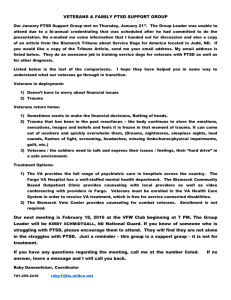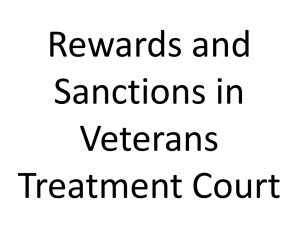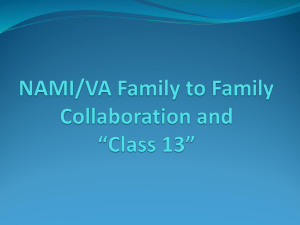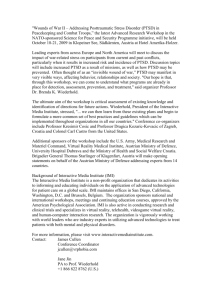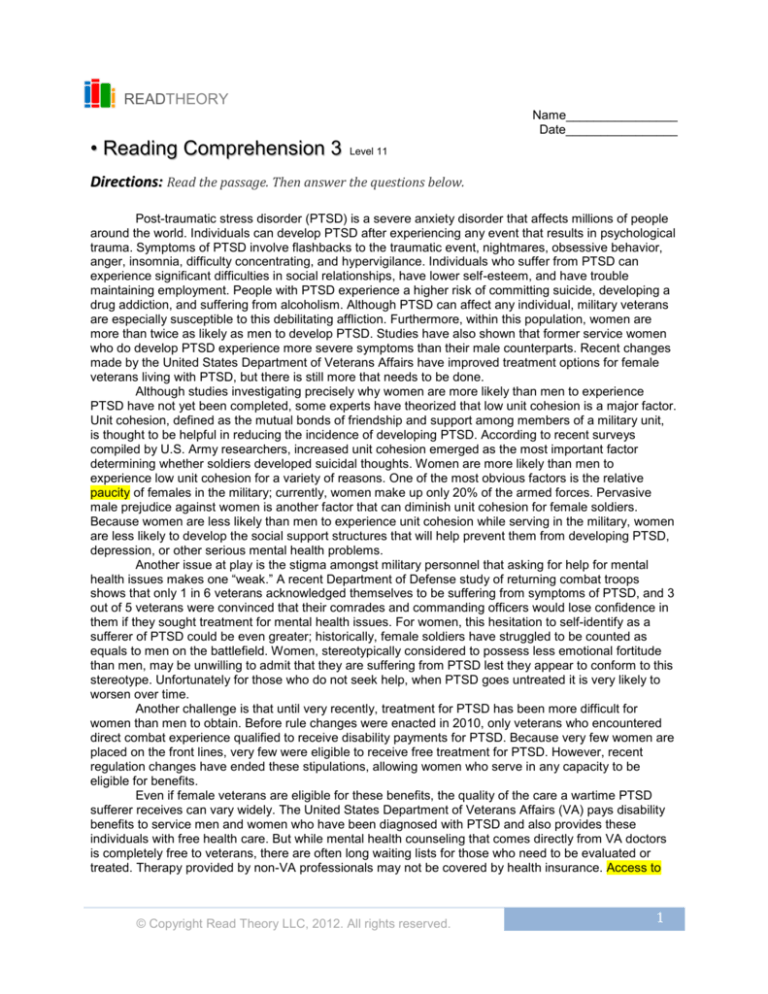
READTHEORY
Name________________
Date________________
• Reading Comprehension 3
Level 11
Directions: Read the passage. Then answer the questions below.
Post-traumatic stress disorder (PTSD) is a severe anxiety disorder that affects millions of people
around the world. Individuals can develop PTSD after experiencing any event that results in psychological
trauma. Symptoms of PTSD involve flashbacks to the traumatic event, nightmares, obsessive behavior,
anger, insomnia, difficulty concentrating, and hypervigilance. Individuals who suffer from PTSD can
experience significant difficulties in social relationships, have lower self-esteem, and have trouble
maintaining employment. People with PTSD experience a higher risk of committing suicide, developing a
drug addiction, and suffering from alcoholism. Although PTSD can affect any individual, military veterans
are especially susceptible to this debilitating affliction. Furthermore, within this population, women are
more than twice as likely as men to develop PTSD. Studies have also shown that former service women
who do develop PTSD experience more severe symptoms than their male counterparts. Recent changes
made by the United States Department of Veterans Affairs have improved treatment options for female
veterans living with PTSD, but there is still more that needs to be done.
Although studies investigating precisely why women are more likely than men to experience
PTSD have not yet been completed, some experts have theorized that low unit cohesion is a major factor.
Unit cohesion, defined as the mutual bonds of friendship and support among members of a military unit,
is thought to be helpful in reducing the incidence of developing PTSD. According to recent surveys
compiled by U.S. Army researchers, increased unit cohesion emerged as the most important factor
determining whether soldiers developed suicidal thoughts. Women are more likely than men to
experience low unit cohesion for a variety of reasons. One of the most obvious factors is the relative
paucity of females in the military; currently, women make up only 20% of the armed forces. Pervasive
male prejudice against women is another factor that can diminish unit cohesion for female soldiers.
Because women are less likely than men to experience unit cohesion while serving in the military, women
are less likely to develop the social support structures that will help prevent them from developing PTSD,
depression, or other serious mental health problems.
Another issue at play is the stigma amongst military personnel that asking for help for mental
health issues makes one “weak.” A recent Department of Defense study of returning combat troops
shows that only 1 in 6 veterans acknowledged themselves to be suffering from symptoms of PTSD, and 3
out of 5 veterans were convinced that their comrades and commanding officers would lose confidence in
them if they sought treatment for mental health issues. For women, this hesitation to self-identify as a
sufferer of PTSD could be even greater; historically, female soldiers have struggled to be counted as
equals to men on the battlefield. Women, stereotypically considered to possess less emotional fortitude
than men, may be unwilling to admit that they are suffering from PTSD lest they appear to conform to this
stereotype. Unfortunately for those who do not seek help, when PTSD goes untreated it is very likely to
worsen over time.
Another challenge is that until very recently, treatment for PTSD has been more difficult for
women than men to obtain. Before rule changes were enacted in 2010, only veterans who encountered
direct combat experience qualified to receive disability payments for PTSD. Because very few women are
placed on the front lines, very few were eligible to receive free treatment for PTSD. However, recent
regulation changes have ended these stipulations, allowing women who serve in any capacity to be
eligible for benefits.
Even if female veterans are eligible for these benefits, the quality of the care a wartime PTSD
sufferer receives can vary widely. The United States Department of Veterans Affairs (VA) pays disability
benefits to service men and women who have been diagnosed with PTSD and also provides these
individuals with free health care. But while mental health counseling that comes directly from VA doctors
is completely free to veterans, there are often long waiting lists for those who need to be evaluated or
treated. Therapy provided by non-VA professionals may not be covered by health insurance. Access to
© Copyright Read Theory LLC, 2012. All rights reserved.
1
mental health professionals who have been specially trained to treat wartime PTSD is often difficult for
those not living near major urban centers.
Perhaps the biggest impediment to achieving quality treatment for women suffering from wartime
PTSD is a lack of research. While both the VA and independent agencies have completed hundreds of
studies researching the prevention of and treatment for PTSD amongst general military populations, there
have been no studies completed that solely target women. Before adequate care can be provided, there
must be greater understanding about the root causes of this issue as it affects women specifically. On
both the research level and the policy level, more must be done to help the women who have sacrificed
so much for their country.
Questions
1) The primary purpose of the passage is to
A. explain why military veterans are more likely than civilians to develop PTSD
B. persuade government officials to increase funding for PTSD treatment centers in non-urban areas
C. denounce the United States military for the way they have handled veterans’ mental health
problems
D. inform readers about the likely warning signs of PTSD among military veterans
E. educate readers about the problem of insufficient treatment available for female veterans with
PTSD
2) According to the passage, all of the following are reasons why females develop PTSD more
frequently than males except
A.
B.
C.
D.
E.
women experience lower unit cohesion than men
women can face negative stereotypes in the military
women are more likely than men to suffer from depression (CORRECT)
males in the military greatly outnumber females
males tend to develop stronger social bonds during their time of service than females do
3) As used in paragraph 2, which is the best antonym for paucity?
A.
B.
C.
D.
E.
certainty
audacity
deference
contentment
abundance
4) Based on information in the passage, it can be inferred that negative stereotypes about women in the
military contribute to their increased likelihood to develop PTSD in which of the following ways?
I.
Some male members of the armed forces subscribe to negative stereotypes about women; this
prejudice may prevent women from forming close bonds with their units.
II. Women may be less likely than men to admit to suffering from PTSD because they do not want to
conform to stereotypes that portray women as weak.
III. Women are aware of the negative stereotypes that pervade the military. This awareness may
lead to a reduction in self-esteem.
A.
B.
C.
D.
E.
l only
II only
I and II only
II and III only
I, II, and III
© Copyright Read Theory LLC, 2012. All rights reserved.
2
5) Based on information in the passage, which of the following statements best reflects the author’s
opinion about the mental health care provided for female veterans?
A. Although the VA has not done nearly enough, state and independent agencies have made up for
government deficiencies.
B. The government has done almost nothing to help; the way we treat our female veterans is a
national disgrace.
C. Because service women are more likely than service men to develop PTSD, mental health care
has been better for female veterans.
D. The VA and other government agencies have attempted to provide mental health care for female
veterans, but most of them refuse to seek treatment.
E. The amount of care provided has improved over the past few years, but it is still insufficient.
6) Which of the following pieces of evidence, if true, would best strengthen the author’s argument in
paragraph 5?
A. Since 2001, when operations in Iraq and Afghanistan began, more than 230,000 women have
served in the United States Military.
B. Studies have shown that those who receive therapy for PTSD are less likely to commit suicide
and develop substance abuse problems.
C. Women are 50% more likely to experience sexual assault while deployed than men.
D. Although experts now argue that intensive cognitive therapy is more effective at treating wartime
PTSD than prescription drugs, most mental health professionals are trained only to offer
pharmaceutical solutions for PTSD.
E. In addition to causing obvious mental and social health problems for those who suffer from the
disorder, PTSD can also cost society up to $6.2 billion in the form of lost labor productivity and
welfare expenses.
7) In paragraph 5, the author writes: “Access to mental health professionals who have been specially
trained to treat wartime PTSD is often difficult for those not living near major urban centers.” Which of
the following conjunctions, used at the beginning of this sentence, would best clarify the sentence’s
role in the paragraph?
A.
B.
C.
D.
E.
Furthermore
Incidentally
Although
Nevertheless
Therefore
8) Based on information in the passage, it can be inferred that the author is most likely someone who
A.
B.
C.
D.
E.
does not believe women should be allowed to serve in the military
is a mental health care professional
has conducted studies on PTSD among veterans
believes that advocating for others can lead to change
is female
© Copyright Read Theory LLC, 2012. All rights reserved.
3
Answers and Explanations
1) E
An author’s purpose is directly related to the content of a passage. In this passage, the author begins in paragraph 1 by identifying
PTSD as a problem, especially for female military veterans. He or she claims that “more that needs to be done” to provide treatment
options for this population. In paragraphs 2 and 3, the author describes two factors that may make female veterans more
susceptible to PTSD than male veterans: low unit cohesion and a desire not to appear weak, especially in light of gender
stereotypes. In paragraph 4, the author states that until very recently, female veterans have had less access than males to
treatment for PTSD. In paragraph 5, the author informs readers that the quality of care a PTSD sufferer receives “can vary widely.”
Finally, in paragraph 6, the author notes the lack of research targeting women PTSD sufferers specifically, and argues that “more
must be done to help the women who have sacrificed so much for their country.” Throughout the passage, the author provides
information about female veterans suffering from PTSD and the problems they face. Based on this overview, we can determine that
the author’s purpose is to educate readers about the problem of insufficient treatment available for female veterans with PTSD.
Therefore (E) is correct. The author focuses specifically on why female veterans are more susceptible to PTSD than male veterans.
He or she notes that military veterans are more likely than civilians to develop it, but does not explain why this is true. This means
(A) is incorrect. Although the author may agree that government officials should increase funding for PTSD treatment centers, the
author’s primary purpose here is to educate, not to persuade. Furthermore, the author addresses a general audience rather than
government officials specifically. This makes (B) incorrect. Although the author does criticize the government for not doing more
about female soldiers’ PTSD, the tone is not so critical that the purpose could be to denounce the government. The author focuses
on providing information more than assigning blame. This eliminates (C). The author briefly mentions symptoms of PTSD in
paragraph 1, but the larger purpose of the passage is not to inform readers about these warning signs. This makes (D) incorrect.
2) C
In paragraph 2, the author mentions that “women are less likely to develop the social support structures that will help prevent them
from developing PTSD, depression, or other serious mental health problems.” This is the only mention of depression in the passage,
so the author does not state or imply that women are more likely than men to suffer from depression. Therefore (C) is correct. In
paragraph 2, the author states, “Women are more likely than men to experience low unit cohesion for a variety of reasons.” Earlier in
the paragraph the author states that low unit cohesion could be a significant factor in the development of PTSD. This means (A) is
incorrect. In paragraph 2, the author notes that “pervasive male prejudice against women is another factor that can diminish unit
cohesion for female soldiers.” Since the author links low unit cohesion to an increased risk of PTSD, this makes (B) incorrect. In
paragraph 2, the author points out that there are far fewer women serving in the military than men, a factor that can contribute to low
unit cohesion, which is linked to an increased risk of PTSD. This eliminates (D). In paragraph 2, the author states that “because
women are less likely than men to experience unit cohesion while serving in the military, women are less likely to develop the social
support structures that will help prevent them from developing PTSD.” This means (E) is incorrect.
3) E
paucity (noun): scarceness; a small number; inadequacy or lack of something.
The author writes in paragraph 2, “One of the most obvious factors [leading to low unit cohesion] is the relative paucity of females in
the military; currently, women make up only 20% of the armed forces.” Based on this information, we can understand that there are
significantly fewer women in the military than men. This tells us that paucity means a small number. Since abundance means a
large number, it is a good antonym. Therefore (E) is correct. Certainty means sureness or conviction. While there is a relative lack of
females in the military, it does not make sense to say there is a relative uncertainty of them. This means (A) is incorrect. Audacity
means boldness or daring. The author does not in any way imply that women in the military lack daring. Rather, this sentence is
about the number of women in the military. This makes (B) incorrect. Deference means respectful submission. The author does not
in any way imply that women in the military are disrespectful or not submissive. Rather, this sentence is about the number of women
in the military. This eliminates (C). Contentment means satisfaction. Although the author discusses potential problems for women in
the military, he or she does not indicate that women in the military are dissatisfied. Therefore (D) is incorrect.
4) C
In paragraph 2, the author states, “Pervasive male prejudice against women is another factor that can diminish unit cohesion for
female soldiers. Because women are less likely than men to experience unit cohesion while serving in the military, women are less
likely to develop the social support structures that will help prevent them from developing PTSD.” This means that male prejudice
against women may limit unit cohesion for women and prevent them from forming close bonds with their units. Low unit cohesion is
cited as a factor that may lead to increased risk of PTSD. This supports option (I). In paragraph 3, the author states that “for
women, this hesitation to self-identify as a sufferer of PTSD could be even greater; historically, female soldiers have struggled to be
counted as equals to men on the battlefield. Women, stereotypically considered to possess less emotional fortitude than men, may
be unwilling to admit that they are suffering from PTSD lest they appear to conform to this stereotype.” This means that some
women hesitate to admit they are suffering from PTSD because they do not want to conform to stereotypes that portray women as
weak. This supports option (II). Although it might be true that women’s awareness of negative stereotypes may lead to a reduction
in self-esteem, this not discussed in the passage. Furthermore, a reduction in self-esteem is cited as a result of PTSD, not a factor
that increases the likelihood of developing PTSD. This eliminates option (III). Therefore (C) is correct.
5) E
In paragraph 1, the author notes that due to “recent changes,” there are now “improved treatment options” for female veterans
suffering from PTSD. In paragraph 4, the author discusses a rule change that now makes mental health counseling available to
women who have not served in combat positions, which increases women’s eligibility for benefits. Despite these improvements, the
author suggests in the final paragraph that the amount of care provided is still insufficient by stating, “More must be done to help the
women who have sacrificed so much for their country.” Based on this information, we can determine that the author believes the
amount of care provided has improved over the past few years, but it is still insufficient. Therefore (E) is correct. The author does not
© Copyright Read Theory LLC, 2012. All rights reserved.
4
suggest that state and independent agencies have made up for government deficiencies, so (A) is incorrect. Although the author is
critical of the government, he or she is not so harsh as to suggest that the government has done almost nothing to help. This makes
(B) incorrect. The author claims that mental health care has been worse for female veterans as compared to males, not better, so
(C) is incorrect. The author states in paragraph 3 that there is a “stigma amongst military personnel that asking for help for mental
health issues makes one ‘weak.’” The author goes on to explain that women may be even more hesitant to ask for help than men
because of negative gender stereotypes. However, the author does not suggest that most female veterans refuse to seek treatment.
This eliminates (D).
6) D
In paragraph 5, the author argues, “Even if female veterans are eligible for these benefits, the quality of the care a wartime PTSD
sufferer receives can vary widely.” The final sentence in paragraph 5 suggests that some doctors do receive specialized training to
treat those who suffer from wartime PTSD, but these doctors are most often located in urban centers. Intense cognitive therapy
might be one of the specialized treatments referred to in paragraph 5, but most mental health care professionals that veterans have
access to may be trained only to offer prescription drugs as treatment. This piece of evidence would support the author’s argument
that different veterans receive different treatment, and that this treatment can vary in its effectiveness. Therefore (D) is correct. The
number of women serving in the military is irrelevant to the quality of care a wartime PTSD sufferer receives. This makes (A)
incorrect. In paragraph 5, the author argues that the quality of care can vary widely, not that there are benefits to therapy. This
means (B) is incorrect. The likelihood of women experiencing sexual assault while deployed could be evidence used to argue that
women develop PTSD at higher rates than men, but the argument in paragraph 5 is specifically about the varying quality of care that
all sufferers of PTSD receive, male or female. This makes (C) incorrect. The costs of PTSD to society could be evidence used to
argue for the importance of treating it, but this evidence does not specifically support the argument that quality of care varies widely.
This eliminates (E).
7) A
In paragraph 5, the author’s main argument is contained in the first sentence: “Even if female veterans are eligible for these benefits,
the quality of the care a wartime PTSD sufferer receives can vary widely.” Later in the paragraph he or she writes: “Therapy
provided by non-VA professionals may not be covered by health insurance. Access to mental health professionals who have been
specially trained to treat wartime PTSD is often difficult for those not living near major urban centers.” The information in the first
sentence is one piece of evidence that the quality of care varies widely for sufferers of PTSD. The information in the second
sentence provides additional or supplemental evidence. Therefore, the conjunction “Furthermore” would be the best choice,
because it signals to the reader that further, related information is forthcoming. This conjunction clarifies the sentence’s role in the
paragraph, which is to provide an additional reason why care varies widely. Therefore (A) is correct. The conjunction “Incidentally”
indicates that the information to follow is in some way a departure from the previous idea, or only loosely connected to the main
idea. This is not the case, so (B) is incorrect. The conjunction “Although” indicates that the information to follow contains an idea that
qualifies or contrasts with the idea presented either previously or directly following. This is not the case, so (C) is incorrect. The
conjunction “Nevertheless” indicates that the information to follow contrasts in some way with the previous point. This is not the
case, so (D) is incorrect. The conjunction “Therefore” indicates that the information to follow is a conclusion based on the preceding
information. This is not the case, so (E) is incorrect.
8) D
In paragraph 1, the author states, “Recent changes made by the United States Department of Veterans Affairs have improved
treatment options for female veterans living with PTSD, but there is still more that needs to be done.” At the end of the final
paragraph, the author reiterates, “On both the research level and the policy level, more must be done to help the women who have
sacrificed so much for their country.” Based on these calls to action, we can determine that the author is advocating for female
veterans who suffer from PTSD. Because the author includes such direct statements of advocacy and states that change is needed,
we can infer that he or she is most likely someone who believes that advocating for others can lead to change. Therefore (D) is
correct. The author does not give any indication that he or she does not believe that women should be allowed to serve in the
military. This eliminates (A). Although the author appears interested in and knowledgeable about mental health care, there is no
information in the passage to suggest that he or she is a mental health care professional. This means (B) is incorrect. The author
cites studies on PTSD among veterans, but this is not an indication that he or she personally conducted such studies. This makes
(C) incorrect. Although the subject of the passage is female veterans, there is no evidence in the passage about whether the author
is male or female. Therefore (E) is incorrect.
© Copyright Read Theory LLC, 2012. All rights reserved.
5


